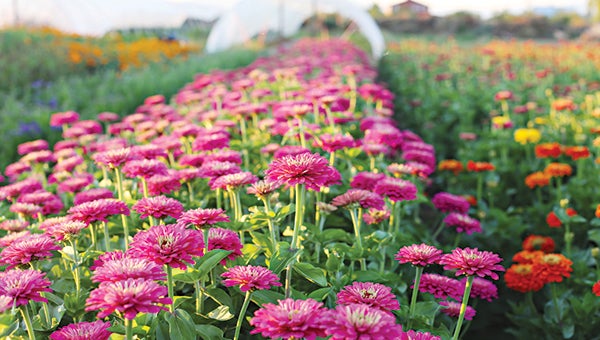A zest for zinnias
Published 12:00 am Sunday, September 7, 2014
Cut flowers allow gardeners to appreciate the beauty and smell of the garden indoors. Long stems and the ability to last for several days after being cut are important qualities when considering which flowers to grow for cutting and arranging. Ten years ago Judy Fitzpatrick planted coreopsis in hopes of using them for floral arrangements at her Eagle Lake home but they only lasted a short time indoors. Her daughter suggested zinnas and they have become a gift that keeps on giving according to Fitzpatrick.
Aztecs called zinnias mal de ojos or hard on the eyes and Europeans several centuries later referred to them as poorhouse flowers or everyone’s flowers after they made their debut there. Zinnias reseeded abundantly and were so easy to grow that even the common folk could successfully master their culture. Not only are they easy to grow but are one of the easiest seeds to save from year to year according to Fitzpatrick who says that she hasn’t bought a packet of seeds in years and freely shares them with friends and neighbors.
Right now in early fall is the time to start saving their seeds. Fitzpatrick uses large paper envelopes and writes the color, whether it is single or double and the year collected on each individual envelope. Seeds older than one year often do not germinate as readily as those stored only one season so the year is important for a seed saver to note.
She goes outside and clips off the dried flower heads from her healthiest plants , brings them inside and leaves them on a paper towel for a couple of days to make sure they are completely dry. Usually she can pull the flower apart and remove the seeds but the whole blossom can be stored if preferred. She keeps them on a shelf in her inside utility room all winter. Using paper for storage is critical with seeds she states. She once tried plastic bags but they didn’t store as well and she lost many of her seeds that year.
Zinnias come in a rainbow of colors except there is no true blue. They add exciting color to a home garden and come in various sizes from the smallest at 10 inches tall to some like “State Fair” that grow to be over 4 feet in height with double blooms which are 3 inches across.
Fitzpatrick is partial to the reds and has a bed of them outside her kitchen window but she also grows pinks, yellows, creams and bright oranges. What she has growing now is tried and true and she likes to combine them with “Margarita” sweet potato vine which also grows in abundance at her house. In fact she commented that she often finds that the sweet potato vine has started rooting in the water of her vases when she takes the zinnas out to make new arrangements each week.
The more zinnias are cut the more flowers they tend to produce. The best time to cut them for bouquets is early in the day or late afternoon. Use clean tools, snipers can be disinfected with a cloth dipped in a solution of 1 part bleach to 10 parts water. Carry a pail of warm water into the garden and remove the zinnia foliage before plunging the stems into the water. Choose only fully opened zinnias for bouquets and arrange in a clean vase into which you have water plus a drop or two of bleach added. Some people like to add 1 part regular 7 Up to one part water also or one of the packets of additives used by the florist trade for cut flowers. The water should be changed every couple of days and no foliage should be left under water in the vase because it decays and shortens the life of the cut flowers.
Zinnias need at least six hours of sun daily, a pH of 5.5-7.5 and do best if organic matter is added into soil prior to planting along with 2 pounds of time release fertilizer per 100 feet of planting area. Never crowd zinnias (8-12 inches apart is ideal) and water the ground around the roots not the leaves. Good air circulation is important to keep them disease free and wet leaves may trigger powdery mildew or disease. A boost of fertilizer late in the season will help them bloom into fall. Container zinnias need additional liquid fertilizer once a month.
Fitzpatrick gives away at least one hundred packets of seeds each year as well as cut flowers to friends and neighbors. She says that bees, butterflies and hummingbirds are drawn to any garden with several zinnias and the colors always delight all who happen to see them in her garden. She also has had success with saving seed from cool weather vegetables such as kale, Swiss chard and lettuces.
•
Miriam Jabour, a Master Gardener and Master Flower Show judge, has been active in the Openwood Plantation Garden Club for over 35 years. Write to her at 1114 Windy Lake Drive, Vicksburg MS 39183.






